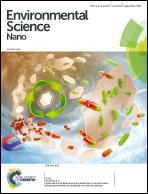Anion recovery from water by cross-linked cationic surfactant nanoparticles across dialysis membranes†
Abstract
Surfactant micelles combined with ultrafiltration can be used for removing specific ions (e.g., phosphate and nitrate) from water. An issue with implementing this technology is the significant and constant loss of surfactant monomers across the ultrafiltration membrane. To overcome this issue, a new cationic surfactant, a quaternary ammonium hydroxypropyl conjugated linoleic acid ester (QACLE), was synthesized that is easy to cross-link with UV light when it is present in aqueous micellar form, forming stable quaternary ammonium stearic acid ester (QASE) nanoparticles with high anionic exchange capacity. The selectivity coefficients of the QACLE micelles towards common anions in natural water were evaluated using a thermodynamic (equilibrium) ion exchange model, and were compared to selectivity coefficients measured for micelles composed of two commercially available cationic surfactants, cetyltrimethylammonium bromide (CTAB) and cetylpyridinium chloride (CPC). The sequence of decreasing affinity for all three self-assembled micellar systems (i.e., QACLE, CTAB and CPC) was: CrO42− > SO42− > HPO42− > NO3− > Br− > NO2− > Cl− > HCO3− > H2PO4− ≈ F−. Using the necessary mass balance and ion exchange reactions, a model was developed to predict the distribution of all anions between the aqueous phase and micellar or nanoparticle phase. Comparing results of anion exchange on QASE nanoparticles to model predictions indicated that the cross-linking of the monomers in the micelles did not change the anion selectivity coefficients. Experimental results, using artificial and real surface waters, and model predictions indicate that the new nanoparticles have the potential for phosphate recovery from waters containing competing anions.



 Please wait while we load your content...
Please wait while we load your content...